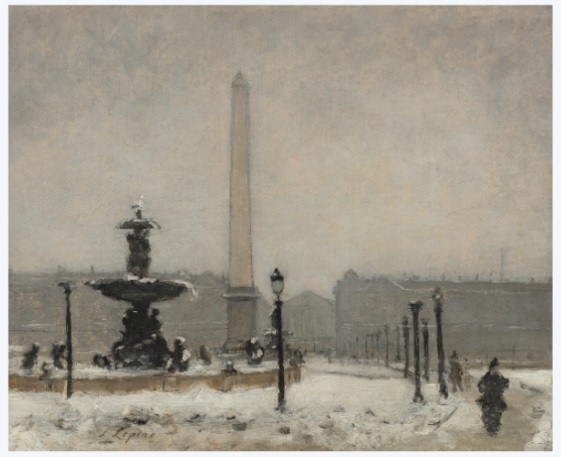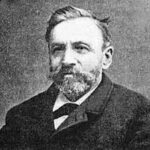
Stanislas Lepine
French, 1835-1892
La Place de la Concorde, 1870s
oil on canvas
15 1/8 x 18 1/4 in.
SBMA, Gift of Mr. Daniel Gainey
1986.68.2

Stanislas Lepine - undated photo
“He always paints with scrupulous fidelity all the aspects of Paris, when lit by the bright rays of the sun, or enveloped in mist.” - Emile Cardon in the 1892 Lepine retrospecKve catalogue at Galeries Durand-Ruel (Lanoe, 246)
RESEARCH PAPER
In this rather small painting, Lepine captures both the grandeur of the Paris cityscape and the beauty of the city in the winter. “La Place de la Concorde” exemplifies both his signature atmospheric style achieved with soft colors and a limited palette and his architectural composition. The horizon is reduced to the roof lines of the Hotel de Crillon on the left and the Naval Ministry on the right broken by the peaked roof of l’Eglise de La Madeleine in the distance and the dramaKc upward thrust of the Obelisk of Luxor in the center of the Place.
The painting is heavily weighted to the left by the massive black fountain representing the seas (the far fountain, seen beyond the lamppost to the right of the obelisk, represents the rivers). The fountain itself parallels the horizontal structure of the buildings as well as the vertical line of the obelisk. The light stone wall around the fountain draws the viewer’s eyes slightly upward to the right to the thin dark line of the walkway connecting the obelisk to the line of lampposts. The lampposts themselves provide a classic geometric perspective element receding to the depth of the painting where the eye turns again to La Madeleine and the obelisk. Furthermore, the black figure in the right foreground not only mimics the verticality of the lampposts but also provides a balance to the black weight of the fountain.
Lepine’s loose brushwork with black and white creates the dirty appearance of the shoveled snow by the walking path, and the impasto application imitates the texture of the accumulated snow. Quickly painted, too, are the figures on the right, adding both immediacy and animation to the otherwise still scene in which even the fountain’s water is frozen in mid-spill.
The light orange underpainting visible through Lepine’s expressive brushwork unites the entire image. The warm undertone informs the sky and suggests that the sun may indeed break through the overcast of the mid-winter day. The luminosity of the sky provides a tonal relationship to all elements of the painting—sky, buildings, snow, walkways. Indeed, the base color is so prevalent that the artist outlines the obelisk to keep it from blending into the sky and losing its form. Only on the light stone wall of the fountain do we see hints of the raw undercoat. As we have seen, that wall is an essential element in moving our eyes throughout this comfortable, subtle, ode to Paris.
Stanislas Victor Edouard Lepine was born in 1835 in Caen, in the Normandy region of France on the English Channel. (See Rehs for the most detailed biography of Lepine.) Little is known of his early life and artistic influences. However, by his late teens he had chosen to be a painter and moved to Paris to study art and copy works in the Louvre. He made friends with a number of artists and was drawn to the work of Johan Barthold Jongkind (1819-1891), a Dutch painter of marine scenes. At the age of 24 Lepine was accepted for the Paris Salon of 1859 with a nocturnal “Port de Caen, Effet de Lune”.
At the same time he developed an interest in landscapes and scenes of Paris, especially views including the River Seine. In the 1860s he apprenticed with Jean-BapKste Camille Corot (1796-1875), one of the great landscapist of France, and learned from him how to express the poetic gentleness we see in his paintings. Although he continued to show in the Paris Salon and with several major Parisian dealers, Lepine’s works proved difficult to sell. He often knew poverty and sometimes received financial help from his friend the artist Henri Fantin-Latour (1835-1904).
Lepine’s subject matter was fairly consistent throughout his career—the ports and villages of Normandy, the landscapes around Paris and the Seine, and city scenes of Paris. His style also did not vary significantly. He used a limited number of colors often applied with thick brushstrokes. Even though his palette and style were closer to that of the somber artists of the Barbizon School than to the light- infused Impressionists, he did participate in the first Impressionist Exhibition in 1874. In reviewing that show, Emile Cardon wrote in “La Presse” of Lepine as “a young landscape painter with a great future, and a conscientious artist” (Cardon)
Lepine suffered from a stiffening of the joints (ankylosis) causing hardening of the bones, at first on one side, then leading to paralysis (Lanoe, 247). Lepine died in Paris in 1892, totally paralyzed and destitute. He is buried at the Church of Saint Peter of Montmartre.
In 1892 shortly after Lepine’s death, the French author and journalist Maurice Guillemot admired how the artist could “delicately render the gray of the morning, interpreting it as an original poet” [Moreau, 1771) –a fitting epitaph for this “original poet” in art.
BIBLIOGRAPHY
Books
Cardon, Emile. “The exhibition of the Revoltes", “La Presse”, April 29, 1874.
http://www.artchive.com/ galleries/1874/74critic.htm
Lanoe-Villene, Georges. “Histoire de l’Ecole Francaise de Paysage depuis Chintreuil jusqu’a 1900”. Nantes: Societe Nantaise d’Editions, 1905. Pp. 245-247.
https://play.google.com/books/reader? id=BvegAAAAMAAJ&hl=en&pg=GBS.PA2475
Leoussi, Athena S. E. “Lepine, Stanislas (-Victor-Edouard)” in Grove Art Online.
https://doi.org/10.1093/ gao/9781884446054.article.T050500 (may require registration)
Moreau, Georges, ed. “Revue Universelle: Annee 1892.” Paris: Librairie Larousse, 1892. P. 1771.
https:// gallica.bnf.fr/ark:/12148/bpt6k2135895/f872.image.r=lepine
WEBSITES
Musee d’Orsay, Paris.
“Quai des Celestins
“Landscape”
https://www.musee-orsay.fr/en/collections/index-of-works/resultat-collection.html? no_cache=1&zsz=1&zs_r_2_z=3&zs_r_2_w=L%C3%A9pine%2C%20Stanislas&zs_ah=oeuvre&zs_rf=mos_ a&zs_mf=21&zs_sf=0&zs_send_x=1&zs_liste_only=1
Norton Simon Gallery, Pasadena
“A Courtyard on the rue de la Fontinelle”
“The Pont de L’Estacade, Paris”
“The Pont Neuf, Paris”
https://www.nortonsimon.org/art/search-the-collection/result? title%5B%5D=&select_earliest_year=&select_latest_year=&earliest_year=&latest_year=&material=&acc ession_id=&show_only%5B%5D=1&sort=1&length=0&keyword=Lepine
Museo Nacional Thyssen-Bornemisza, Madrid
“Stanislas Lepine” (Dominique Lora)
“The Seine at the Pont de Sevres” (Ronald Pickvance)
“Le Mariage a St. Etienne du Mont” (Guillermo Solana)
https://www.museothyssen.org/en/collection/artists/lepine-stanislas
Rehs Gallery, New York. “Biography – Stanislas Lepine (1835-1892)”.
h[ps://rehs.com/eng/default-19th20th-century-artist-bio-page/?fl_builder&artist_no=387&sold=1
COMMENTS
French painter. Originally self-taught, he became a student of Corot and an admirer of Johan Barthold Jongkind, who influenced him in his choice of ships as subject-matter. He also learnt from Jongkind not only how to paint ships accurately but also how to render the depth of the sky and the clarity of waves, as in "Sailing Boats in Caen Harbour" (priv. col., see Serullaz, p. 48). He produced a number of nocturnes of the port of Caen, including "Boats on the River", "Moonlight" (Reims, Mus. St Denis) and "Port of Caen, Moonlight Effect" (c. 1859), the latter painting marking his début in 1859 at the Salon in Paris. He specialized in the depiction of the steep banks of the River Seine and the movement of the water, as in "The Seine at Bercy" (c. 1866–72; Edinburgh, N.G.). He also executed views of Paris and was particularly successful in reproducing the atmosphere of the city, especially its overcast days with cloudy skies, as in "Nuns and Schoolgirls Walking in the Tuileries Gardens, Paris" (c. 1871–83; London, N.G.). He also rendered such picturesque scenes in Paris as the old streets of Montmartre where he himself lived (e.g. "Rue Norvins at Montmartre", 1878; Glasgow, A.G. & Mus.). In 1874 in Paris he exhibited "Banks of the Seine" (1869; Paris, Mus. d’Orsay) with the Société Anonyme des Artistes, Peintres, Sculpteurs, Graveurs etc, the first public showing outside the Salon by the Impressionist painters. Although his work can be said to anticipate the Impressionists’ interest in light effects, his brushwork, as well as his depiction of light effects, is much more delicate and subtle than theirs.
- Athena S. E. Leoussi, Grove Art Online, 2003
SBMA CURATORIAL LABELS
Lépine was a student of Camille Corot and, like the great Barbizon school artist, he specialized in capturing fugitive effects of climate and atmosphere. He is known for his many moonlit port scenes, but he also specialized in picturesque urban views of Paris, such as this one. Like the marine specialist Eugène Boudin (teacher of Claude Monet), Lépine was particularly attracted to the gray light of overcast days. In this painting, the familiar outline of the Obelisk of Luxor becomes indistinct through the muffling haze of a frigid winter’s day. Visible daubs of paint evoke the drifts of snow, sullied by the dirt and grime of city life.
- Ridley-Tree Reopening, 2021
